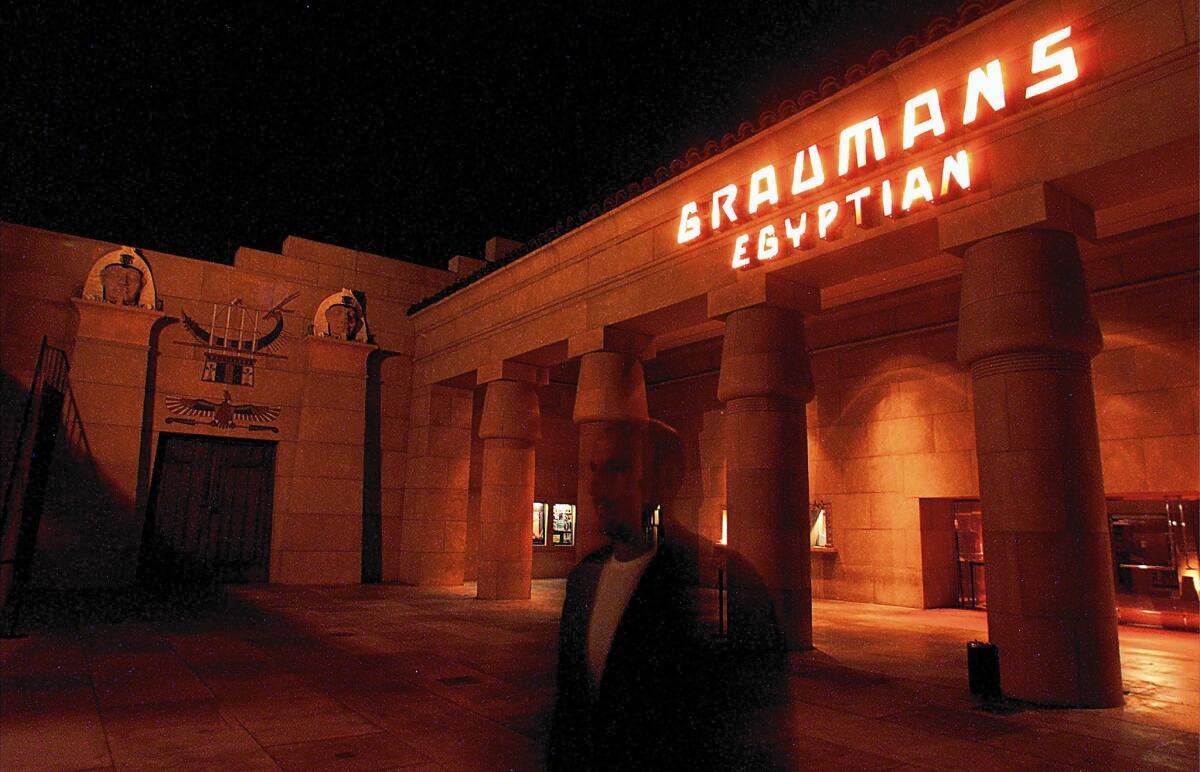Preservationists celebrate the beauty of Hollywood’s architectural stars

More than 100 people gathered in the Egyptian Theatre recently for a presentation about rapidly changing Hollywood.
Giant cranes dot the Hollywood skyline, dominating many a view. Those who treasure the area’s architectural history worry about them daily.
Down go old buildings and up rise shiny towers. Sometimes it seems to happen in a flash.
On a recent afternoon, more than 100 people gathered in the Egyptian Theatre — built in 1922 — for a presentation about rapidly changing Hollywood.
They had come to hear about buildings demolished in the name of development and about others left standing but ruined by changes that had stripped away their essence.
They wanted to find out about the latest twists, like the controversial use of spot zoning and the dwarfing of the old by the new. Developers, for example, have pledged to preserve the Hollywood Palladium (a 1940s Streamline Moderne building) and Crossroads of the World (built in 1936 and called America’s first outdoor shopping mall) but plan to flank them with skyscrapers.
Some who showed up to hear speakers from the Art Deco Society of Los Angeles and Hollywood Heritage — two all-volunteer organizations that wage preservation battles — were the sort of history buffs who like to live and breathe it.
Society board member Kathy Shoemaker entered the lobby in period dress, catching the eye of George Kiel, who was manning a Hollywood Heritage book table.
Her mocha and black drop-waist day dress in silk de chine, he told her, was something a young woman might have purchased in 1926 — an older woman perhaps a few years later once the idea was less daring.
“Where are the cocktails?” Shoemaker asked, when he identified her 1930s velvet cocktail hat.
“It’s Prohibition, you know,” he said. “They’ll be behind your seat.”
People took their seats in the theater. The lights were cut.
“We hope you enjoy this virtual tour, but we’re also hoping that you will go out and look at these buildings in the flesh or, more accurately, in the brick and mortar,” said Margot Gerber of American Cinematheque, the nonprofit that owns the Egyptian.
Speakers took turns showing slides of Art Deco gems and talking about the preservation fights they’d won and lost, as well as the ones in progress.
In the safe column were landmarks like the Pantages Theatre. Built in 1930, it is largely intact — although the original chandeliers apparently had been sold during World War II for steel.
The audience was urged to walk along Hollywood Boulevard and take a good look at some less famous buildings too: the zigzag-moderne style Kress five-and-dime, which opened in 1934 and is currently for lease; the J.J. Newberry store, now home to Hollywood Toy & Costume; the Max Factor Building, today’s Hollywood Museum, whose facade reportedly sparkles thanks to crushed makeup-table lights.
Images also flashed on the screen of buildings that stand only in memory, like the curvaceous, Streamline Moderne NBC Radio City Building, demolished in 1964, which had a thunderbolt streaking across its lobby terrazzo.
And of others whose past glory is a memory, even though they still stand.
The L.A. outpost of New York’s Sardi’s restaurant, designed by Rudolph Schindler, had its interior destroyed in a kitchen fire in 1936, three years after it opened. The building remains, but not what made it special. Once a haunt of Marlene Dietrich and Joan Crawford, now it’s a strip club.
Vigilance is necessary, said Hollywood Heritage President Richard Adkins, who asked audience members to walk the neighborhood and keep their eyes peeled.
“Tell us, call us, notify us” about construction that doesn’t seem right, he said.
Some Hollywood treasures, Gerber said, have been brought into the modern age successfully, reused in ways that retain their integrity and ensure their survival.
She explained how the Egyptian had once been a silent movie house seating 2,016. The historic walls of the building remain, while a modern theater sits inside the old shell.
“Think for a moment of what it would have been like to be here on opening night, where Mary Pickford, Douglas Fairbanks and Charlie Chaplin sat under the same sunburst ceiling that you’re sitting under today,” Gerber said.
Sometimes getting to know owners and developers and making them aware of the historical significance of a site can make all the difference, said John Thomas, president of the Art Deco Society.
The meticulously restored Streamline Moderne CBS Columbia Square, which opened in 1937 as the first building designed for live radio broadcast, for instance, now is the home of NeueHouse, a private-membership shared working space for “leading entrepreneurs and creative teams.”
John Girodo, who heads Hollywood Heritage’s preservation issues committee, called the newly spiffed-up space “the crown jewel Hollywood preservation project.”
“The amazing architecture of this city can and has been modernized,” he said. “It can develop and grow without demolition.”
Twitter: @latimescitybeat
ALSO
2 LAPD officers are charged with sexually assaulting women while on duty
Sentenced to prison for assault, teenage ‘parachute kids’ deliver warning to adults in China
Hollywood hospital pays $17,000 in bitcoins to hackers who took control of computers
More to Read
Sign up for Essential California
The most important California stories and recommendations in your inbox every morning.
You may occasionally receive promotional content from the Los Angeles Times.











